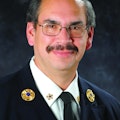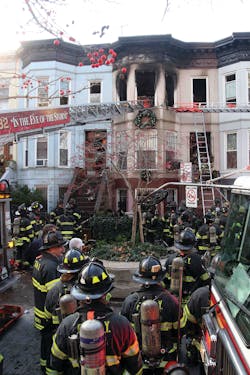Recently across the country, there have been several close calls involving firefighters. The only reason they didn’t suffer further injury was they had all of their personal protective equipment (PPE) on and in proper fashion. Because of the increased use of technology, we know almost instantly what is going on in the U.S. fire service from coast to coast and from around the world – good and bad. Websites, smartphones, texts, video feeds, email and other social media bombard us 24 hours a day. Apps are available to hear dispatches and radio traffic from fires in many large cities nationwide with a flick of a finger. This was unheard of, impossible or unthinkable just a few years ago.
Here are some interesting facts from the National Fire Protection Association (NFPA): A fire department in this country responds to a fire every 24 seconds; a structure fire every 65 seconds; an outside fire every 50 seconds and a vehicle fire every 146 seconds. During 2010, there were 482,000 structure fires, 215,000 vehicle fires and 634,000 outside and other fires.
A fire instructor at a national conference I attended asked an audience of firefighters how many of them respond to 1,000 structure fires a year. No hands went up. Five hundred? Two-fifty? A couple of firefighters raised their hands. One hundred? A few more responded. Seventy-five? A few more acknowledged. Fifty? A few more hands went up. Twenty-five? A couple more answered. Then he asked how many respond to 10 to 15 fires a year. Most of those in the audience raised their hands.
The point the instructor was making is that most firefighters do not respond to many structure fires, but they still must train, prepare, execute and be ready for the unknown on the fireground. The fireground has gotten more dangerous than ever because of interior combustibility, lightweight construction, shorter time to flashover, less manpower in certain companies, increased response time in many areas and a host of other possibilities that can only hurt or kill you.
The best in PPE can only offer a short time of protection. It is not meant for you to be caught in a room with direct flame impingement for a long time. Your training should make you avoid being caught in situations like that. Many firefighters survive flashover, unlike others who weren’t so lucky in the past, because they wearing all of their PPE in proper working order. We have all seen videos, pictures and streaming lines of communication showing firefighters unprepared to go to work. Did you ever ask yourself, when you watch some of these recent incidents, what are they doing? Hopefully, you will never appear in any of these “videos of the day” when you are about to go in harm’s way.
With the recent arson wave in greater Los Angeles, CA, we present a cover story/photo spread showing many of these incidents. Aggressive work by the Joint Arson Task Force led to the arrest of a suspect within a few days. See page 50 for the rest of the story.
It’s not too late to make arrangements for Firehouse World 2012, taking place in San Diego, CA, Feb. 19-23. Besides many new topics and speakers, a special chiefs program has been introduced. This VIP program offers many new and exclusive benefits for chiefs who are attending the conference. The three-day exhibit hall features many new companies and products. Networking events include a first-time fund-raising event on the aircraft carrier USS Midway and an event at the San Diego Fire Museum. See www.firehouseworld.com for details.
For comments and suggestions, please contact us at [email protected].
HARVEY EISNER is editor-in-chief of Firehouse® and a retired assistant chief of the Tenafly, NJ, Fire Department, which he joined in 1975 and served as chief of department for 12 years. He also was a firefighter in the Stillwater, OK, Fire Department for three years while attending Oklahoma State University. Eisner is an honorary assistant chief of the FDNY and program director for the Firehouse Expo, Firehouse World and Firehouse Central conferences. He has covered many major fires and disasters and interviewed numerous fire service leaders for Firehouse®.
4
2012 firefighter line-of-duty deaths at presstime.
80
2012 residential fire fatalities at presstime.
?
About the Author

Harvey Eisner
Editor Emeritus
HARVEY EISNER was named Editor Emeritus of Firehouse® after serving 15 years as Firehouse's Editor-in-Chief. He joined the Tenafly, NJ, Fire Department in 1975 and served as chief of department for 12 years. He was a firefighter in the Stillwater, OK, Fire Department for three years while attending Oklahoma State University. Eisner was an honorary assistant chief of the FDNY and program director for the Firehouse Expo, Firehouse World and Firehouse Central conferences. He covered many major fires and disasters and interviewed numerous fire service leaders for Firehouse®
